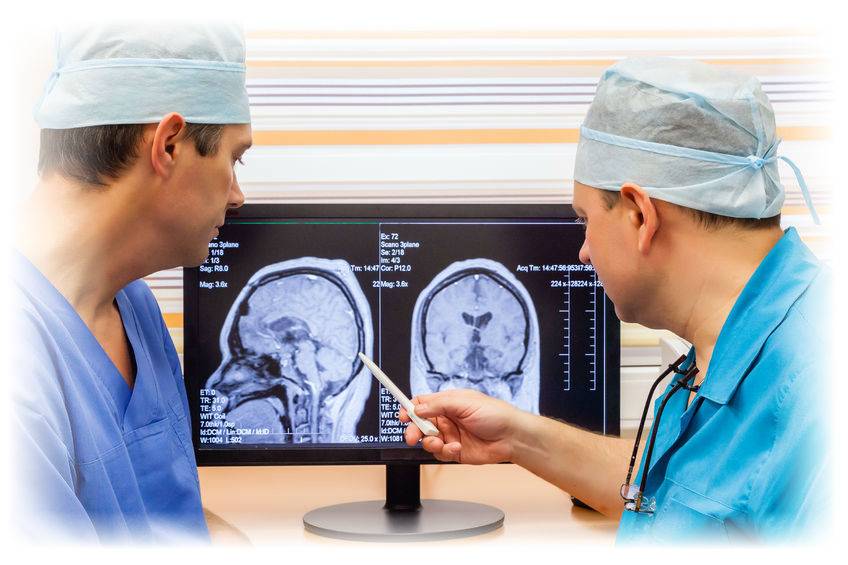Filter By Location
Show All Locations
Edison
Livingston
Paterson
Ridgewood
Toms River
Wayne
Eatontown
Glen Ridge
Nyack
Hazlet
Neurosurgeons of New Jersey is home to a sub-specialized team of neurosurgeons dedicated to the study and treatment of Chiari malformation. Together, we can help determine which treatment option is best for you and your particular goals.
If you look at the inside view of a skull, you will see many grooves and holes that fit the brain perfectly and allow nerves and blood vessels to pass through. The brain and skull develop together, allowing for maximum protection and ideal function.
A Chiari malformation is a problem with one of these grooves, where a part of the brain called the cerebellum fits. The space in the bone is too small to accommodate the cerebellum, a problem that is typically developmental in Type 1 Chiari malformation. As a result, the cerebellum is displaced down through a hole at the bottom of the skull, the foramen magnum.
The foramen magnum is the passageway for the spinal cord, which is cushioned by a liquid called cerebrospinal fluid (CSF). If the passageway is blocked, as it is by the cerebellum in a Chiari malformation, there can be a buildup of CSF, as well as excessive pressure on the brain stem and/or spinal cord.

Some patients with Chiari malformation will not exhibit symptoms until adulthood, while others may never exhibit any symptoms at all. If symptoms are present, they will typically involve problems arising from direct pressure on the brainstem and/or spinal cord or blockage of cerebrospinal fluid (CSF).
If you suffer from Chiari malformation, you may have experienced:



Many patients with a Chiari malformation are identified incidentally and do not require any treatment. If you experience mild symptoms, these can often be managed non-operatively.
Severely symptomatic Chiari malformation patients may require surgery to resolve the anatomical problem. If your condition is causing symptoms, your physician may recommend surgery to remove the blockage at the foramen magnum and restore the normal flow of CSF. This will stop the disease from getting worse, as well as stabilize or alleviate your symptoms. The particular procedure your surgeon may recommend will depend upon multiple factors, including your age, disease progression and particulars of your case.
The goal of dural opening Chiari Decompression is to prevent further injury to the spinal cord by making space for the lower regions of the cerebellum outside of the spinal canal while also, hopefully, providing relief from some of the associated symptoms.
When a surgeon performs a cervical laminectomy, he or she is removing the back section of the upper vertebral bone(s) in order to help create space and alleviate pressure around the spinal cord. This procedure is often performed in combination with a Suboccipital Craniectomy in patients with Chiari malformation.
Spinal fusion is a procedure performed in combination with posterior fossa decompression, for patients who have spinal instability due to coexisting conditions that cause additional issues, such as Ehlers-Danlos syndrome.
Transnasal / Transoral decompression is a procedure where the surgeon enters through the nose or the mouth, respectively, to remove a section of a vertebra causing compression in patients with Chiari in conjunction with other conditions such as basilar invagination.
CSF diversion uses a flexible tube to direct CSF around the blockage, allowing it to flow to another area of the body and be absorbed.
In conjunction with these procedures, neuromonitoring is performed by trained specialists. Neuromonitoring allows surgeons to identify subtle improvements in nerve pathway functioning in the operating room at critical surgical steps. Neurosurgeons use this during surgery as a safeguard to help prevent complications when operating on delicate structures such as the brain and spinal cord.
This minimally invasive approach, pioneered by our surgeons at Neurosurgeons of New Jersey, achieves the same result as a standard decompression but through a much smaller incision and with added benefits.
The surgeon, operating through a small incision with endoscopic or microscopic tools, will remove sections of the occipital bone and/or spine in order to create additional room for the cerebellum.
In conjunction with these procedures, neuromonitoring is performed by trained specialists. Neuromonitoring allows surgeons to identify subtle improvements in nerve pathway functioning in the operating room at critical surgical steps. Neurosurgeons use this during surgery as a safeguard to help prevent complications when operating on delicate structures such as the brain and spinal cord.
Many patients with a Chiari malformation are identified incidentally and do not require any treatment. If you experience mild symptoms, these can often be managed non-operatively.
Severely symptomatic Chiari malformation patients may require surgery to resolve the anatomical problem. If your condition is causing symptoms, your physician may recommend surgery to remove the blockage at the foramen magnum and restore the normal flow of CSF. This will stop the disease from getting worse, as well as stabilize or alleviate your symptoms. The particular procedure your surgeon may recommend will depend upon multiple factors, including your age, disease progression and particulars of your case.
The goal of dural opening Chiari Decompression is to prevent further injury to the spinal cord by making space for the lower regions of the cerebellum outside of the spinal canal while also, hopefully, providing relief from some of the associated symptoms.
When a surgeon performs a cervical laminectomy, he or she is removing the back section of the upper vertebral bone(s) in order to help create space and alleviate pressure around the spinal cord. This procedure is often performed in combination with a Suboccipital Craniectomy in patients with Chiari Type 1.
Spinal fusion is a procedure performed in combination with posterior fossa decompression, for patients who have spinal instability due to coexisting conditions that cause additional issues, such as Ehlers-Danlos syndrome.
Transasal / Transoral decompression is a procedure where the surgeon removes a section of a vertebra causing compression in patients with Chiari in conjunction with other conditions such as basilar invagination.
CSF diversion uses a flexible tube to direct CSF around the blockage, allowing it to flow to another area of the body and be absorbed.
In conjunction with these procedures, neuromonitoring is performed by trained specialists. Neuromonitoring allows surgeons to identify subtle improvements in nerve pathway functioning in the operating room at critical surgical steps. Neurosurgeons use this during surgery as a safeguard to help prevent complications when operating on delicate structures such as the brain and spinal cord.
This minimally invasive approach, pioneered by our surgeons at Neurosurgeons of New Jersey, achieves the same result as a standard decompression but through a much smaller incision and with added benefits.
The surgeon, operating through a small incision with endoscopic or microscopic tools, will remove sections of the occipital bone and/or spine in order to create additional room for the cerebellum.
In conjunction with these procedures, neuromonitoring is performed by trained specialists. Neuromonitoring allows surgeons to identify subtle improvements in nerve pathway functioning in the operating room at critical surgical steps. Neurosurgeons use this during surgery as a safeguard to help prevent complications when operating on delicate structures such as the brain and spinal cord.